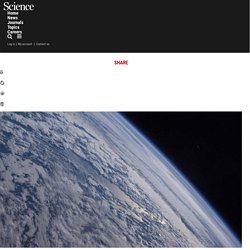

Climate Kids Review for Teachers. Climate Kids is a comprehensive website from NASA covering a variety of global climate change topics.

The website provides many ways to engage in learning, including games, hands-on activities, facts, videos, and career profiles. The site is organized into categories such as Atmosphere, Water, Weather & Climate, Plants & Animals, and Energy. The Big Questions section introduces students to the basics and provides answers to "What is global climate change? " Posters. Global Warming explained in 3 minutes. What is Climate Change? Global Action / Connected 2017 Level 4 - Where to Next? / Connected / Instructional Series / English - ESOL - Literacy Online website - Instructional Series. Atmospheric carbon last year reached levels not seen in 800,000 years.
The concentration of carbon dioxide (CO2) in Earth’s atmosphere reached 405 parts per million (ppm) last year, a level not seen in 800,000 years, according to a new report.

It was also the hottest year on record that did not feature the global weather pattern known as El Niño, which is driven by warmer than usual ocean waters in the Pacific Ocean, concludes the State of the Climate in 2017, the 28th edition of an annual compilation published by the National Oceanic and Atmospheric Administration (NOAA). Overall, 2017 ranked as the second or third warmest year, depending on which measure is used, since researchers began keeping robust records in the mid-1800s. Even if humanity “stopped the greenhouse gasses at their current concentrations today, the atmosphere would still continue to warm for next couple decades to maybe a century,” said Greg Johnson, an oceanographer at NOAA’s Pacific Marine Environmental Laboratory in Seattle, Washington, during a press call yesterday about the report. Planet Earth is fragile. For Educators. Climate change: evidence and causes.
Project background The Royal Society and the US National Academy of Sciences, with their similar missions to promote the use of science to benefit society and to inform critical policy debates, offer this new publication as a key reference document for decision makers, policy makers, educators, and other individuals seeking authoritative answers about the current state of climate change science.

The publication makes clear what is well established, where consensus is growing, and where there is still uncertainty. It is written and reviewed by a UK-US team of leading climate scientists. It echoes and builds upon the long history of climate-related work from both national science academies, as well as the newest climate change assessment from the United Nations’ Intergovernmental Panel on Climate Change. This work was kindly supported by the Raymond and Beverly Sackler US-UK Scientific Forum. Videos. Climate Change: Evidence and Causes.
How to Change Minds About Our Changing Climate: Let Science Do the Talking the Next Time Someone Tries to Tell You...The Climate Isn't Changing; Global Warming ... Other Arguments It's Time to End for Good, Seth B. Darling, Douglas L. Sisterson - Amazon.c. Amazon. Science of Climate Change in 24 Steps - Google Tabellen. Climate Science: What You Need To Know. Why People Don't Believe In Climate Science. Antarctic Glacier Collapse Means Sea-Level Rise Now ‘Unstoppable’ Climate change is a large, multi-faceted issue so it is hard to name any one aspect as being most important.

However, one aspect that is hard to ignore is the fact that a rising sea level has massive socioeconomic implications. Unfortunately, a new paper from lead author Eric Rignot at NASA’s Jet Propulsion Laboratory published in Geophysical Research Letters claims that some glaciers in West Antarctica “have passed the point of no return” and are sliding into the ocean where they will melt and contribute to increased sea-level. A section of glaciers along West Antarctica’s coastline on the Amundsen Sea was previously predicted to be solid enough to last thousands of years. A new report, however, finds that the ice will slip into the water and melt much faster than expected.
These massive glaciers are releasing tremendous amounts of water each year; nearly the equivalent of the entire Greenland Ice Sheet. Mother Polar Bear and Cubs Emerging from Den - BBC Planet Earth. Take the Northern Seasons tour. Polar Bear Wall - Polar Bears. Basic Facts About Polar Bears. Polar bears are the largest land carnivores in the world, rivaled only by the Kodiak brown bears of southwestern Alaska.

Polar bears sit at the top of the food chain in the biologically rich Arctic. The most carnivorous of the bear species, polar bears feed primarily on the fat of ice-dependent seals. The remains of these seals provide food for many other Arctic wildlife species, giving polar bears a vital role in their ecosystem. Polar bears are marine mammals, and spend much of their time on Arctic sea ice. Many adaptations make polar bears uniquely suited to life in icy habitats. Did You Know? Polar bears have black skin to absorb heat, but their fur appears white to blend in with their environment. Diet Polar bears feed almost exclusively on ringed seals and bearded seals. Population. Climate Classroom Kids. Why Focus on the Arctic in Climate Change Instruction?

Polar_Bear_Artic_Ed_Guide.pdf. The 97% consensus on global warming. PBI Maternal Den Study. 21197 50628 1 SM.